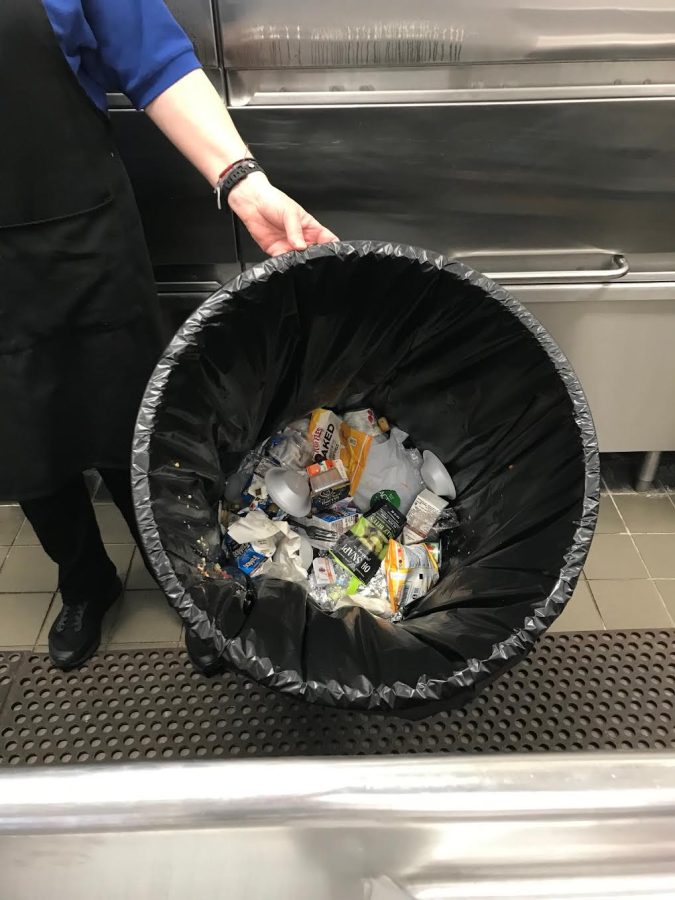Food for Thought; Waste in the High School Cafeteria
The amount of waste after a few students throw their food away.
I remember the first time I witnessed it. The tray lay braced on a pile of others, all of them laden with plastic plates, forks, knives, spoons, and bowls. Among these utensils sat the food they were meant to help students eat, most picked at, some untouched. This tray in particular was the worst of them: an entire slice of pizza laying there whole. And then, simple as that, into the trash it all went.
This amount of waste is a problem.
“It’s a huge concern to our department as well as other Food Service Departments across the country, especially because it adds unnecessary additional cost to the Food Service Program,” said Mr. Gregory Martin, Coordinator of Food Services for Southern Lehigh School District. “Why should we make students take something they aren’t going to eat, just to have it thrown in the trash?”
To elaborate on those costs, the US Bureau of Labor Statistics measures that within the onset of the COVID-19 pandemic, from 2019 to 2020, the Consumer Price Index (CPI) for all food items in America increased by 3.9%. They then find that the CPI for food products increased a further 6.1% throughout 2021, in what they call “the largest 12-month increases in at least 13 years.” To put this in context, students could purchase the main entree, a vegetable, fruit, and milk for $3.05 during the 2018-2019 school year. By the 2021-2022 school year, this same meal would sell for $3.36 if scaled to CPI inflation.
While a 31 cent increase may not seem like a lot to students, consider that from last school year to date, they have not been the ones paying that increase. In cafeteria checkout lines, that baseline lunch remains free, meaning that the tab is picked up by governmental subsidies to the school. It is pertinent to note that, while free lunch is a lifesaver to some families during the pandemic, it can also contribute to students undervaluing the food, resulting in the amount of waste we now see. Yet all these meals now landing in the trash are paid for by someone, so just how much does that total out to?
Estimating that about a fifth of Southern Lehigh High School’s student population accepts the free lunch option, that would result in $672 worth of food per day. Certainly not all of that is being disposed of, but, when asked how much truly was, cafeteria worker Ms. Karen Himmelsbach’s answer was unambiguous.
“Oh my gosh,” she said. “A lot. I really wish we didn’t have to throw so much out.”
Furthermore, that $672 value rises yet more in order to account for a whole other category of careless discard.
“Condiments as well as unused plastic utensils & napkins get tossed in the trash as well,” Mr. Martin said. “This adds undue additional cost to the Food Service Department’s budget and is also adding single use plastic to the landfill unnecessarily.”
So, while all that is clearly an issue, it now comes time to look at solutions.
The first comes down to a more personal level – an effort anyone can make, and which I’d encourage everyone to try. By simply bringing along their lunch bag with an empty container or two, students would be able to store their leftovers to eat after school. Fruits such as bananas and apples save well, are offered frequently, and are required for a lunch to be free, so I urge students to preserve rather than discard them.
Secondly, the High School’s Ecology Club has been considering establishing a compost bin in the cafeteria. This would allow students to dispose of leftovers such as fruits, vegetables, grains, meats, and even some types of paper napkins in an ecologically responsible way.
“The compost bins are in the courtyard area and they’ve been there for a while. [Now] we want to make bins next to the garbage bins,” said freshman Ecology Club member Amanda Smith. “We’re a little worried, though, that students will put trash in them.”
Among other ideas, Smith said the club plans to put the bins in the teachers lounge first as a test run.
This is an enormous step in the right direction, especially when one delves deeper into the environmental effects of food waste. According to Move For Hunger, a non-profit organization centered around providing proper nutrition to all, decomposing food accounts for 6.7% of global greenhouse emissions.
The UN Food and Agriculture Organization said that “the carbon footprint of food produced and not eaten is estimated to 3.3 Gtonnes [3.3 billion tons] of CO2 equivalent: as such, food wastage ranks as the third top emitter after the USA and China.”
Clearly, this is a worldwide problem; however, all considered, one of the best solutions for students is to simply be aware of the price 一 both economic and ecologic 一 of thoughtless waste.
“I honestly do believe students should be cognizant of the food waste situation and help to control as much as they can,” Mr. Martin said. “I don’t believe it’s possible to completely change everything, but it could certainly help with a portion of the waste.”

Alexis Behrens has been an enthusiastic member of the Spotlight since the very beginning of her time at Southern Lehigh High School. As a freshman, she...


